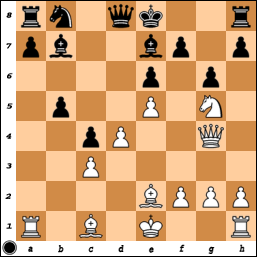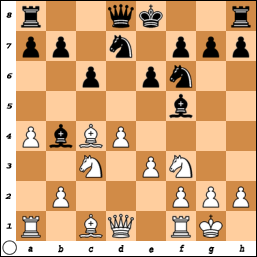The Dutch Variation: Introduction and 9 Qe2
The Dutch Variation: 9 Nh4 and Related Lines
Knight to the Right: 6 Nh4
The Tolush-Geller Gambit: 5 e4
Fifth Move Alternatives
The Errot
Quiet Queen Moves
The Argentinean Defence
The Exchange Variation
Odds and Ends
FM Vigus has branched out in new directions as regards nomenclature. The slightly off-beat way of meeting: 1 d4 d5 2 c4 c6 3 Nf3 Nf6 4 Nc3 dxc4 5 a4 Bf5 6 Ne5 Nbd7 7 Nxc4 with 7 …Nb6 (as opposed to the more common 7 …Qc7) is named The Sokolov Variation. 1 d4 d5 2 c4 c6 3 Nf3 Nf6 4 e3 Bg4 is named The Errot as it carries with similar themes as The Torre Attack, only in reverse. The Argentinean Defence refers to: 1 d4 d5 2 c4 c6 3 Nc3 dxc4

The sharpest try for White is the Tolush-Geller Gambit, which still needs careful attention, although theoretically it should struggle.
‘It must not be underestimated and in many cases leads to very complex play. The computer age, however, is not kind to such speculative gambits and theoretically speaking White is on very precarious ground here.’

This is a critical position. FM Vigus recommends 13...Bd5! Here, as it: ‘..prepares …b5-b4 while enabling the queen’s knight to come to c6, and shores up the e6-pawn‘. The tactical nuances are all competently covered and should be analysed in conjunction this note: ‘The most important advice is: don’t panic!’
I particularly enjoyed the section on the Exchange Variation. It is clear that for The Slav to be a viable weapon for Black, rather than merely a holding device, then the second player must find some way to infuse life into position after 1 d4 d5 2 c4 c6 3 cxd5 cxd5. White usually enjoys a slight pull against symmetrical systems.
Here, considerable attention is devoted to a less obliging method of play.
1 d4 d5 2 c4 c6 3 cxd5 cxd5 4 Nc3 Nc6 5 Nf3 Nf6 6 Bf4 Nh5

‘It is time to introduce the Russian Counterattack, a system for Black that has been unaccountably neglected in books on the Slav despite having served as the standard Soviet antidote to the Exchange for generations.’
The suggested repertoire is narrow but that’s not such a bad thing; there is no doubting that the Slav is virtually fireproof and the lines given here are not at all likely to be blown away by any big novelties. Consequently, this opening book should enjoy a longer than average shelf-life.

The Greatest Ever Chess Opening Ideas
By IM Christoph Scheerer
Everyman Chess
The evolution of chess ideas is an interesting topic for a book and one that requires great research. The bibliography is very impressive, running to five full pages; the author has clearly left no stone unturned in his desire to unearth relevant stories.
All the standards are there, from the ancient tales of Ruy Lopez and Greco, Marshall’s original Attack against Capablanca, the rise of the Hypermoderns, through to modern times and Kasparov’s final over-the-board contributions in his retirement tournament.
Example number 1 shows the ancient Italian Game and over 430 years later, in chapter 50, ‘Hot Off the Press’, brings the history of the development of chess opening bang up to date with Topalov’s bomb at Wijk aan Zee earlier this year:
 Topalov - Kramnik
Topalov - Kramnik A classic example is the tale of the Gothenburg Variation of the Najdorf Sicilian - in which Najdorf, Panno and Pilnik took on the might of Spassky, Keres and Geller, all in the same round of the 1955 Interzonal tournament (with a full view of each other’s games on the demonstration boards) is recounted in full.

Geller led the way with 11 Nxe6! and the Soviets went on to record three victories.
Each chapter concludes with a rating, based on the following criteria:
Shock Value
Effectiveness Rating
Longevity Rating
Creativity Value
I’m not so sure that such a rating system works particularly well, or indeed that it is necessary. 5/5 is the most common rating although it is clearly indicated when the author believes an opening has seen better days. The Jaenisch Gambit is one such variation judged to be a thing of the past.
‘We have reached a position in which it is difficult to find any compensation for the missing pawn.’

‘I wonder if Radjabov will continue to employ the Jaenisch, and I’m more than curious to see what he has planned against the approach recommended in this chapter! I just think that the Jaenisch is not playable anymore…’
This book walks the line between presenting pure theory and a prose history of chess openings (‘Theostorical‘ as the author has it). However, it keeps its balance very well and makes for a most interesting read, ideal for browsing, delightful for dipping into.
It’s a big book - 368 pages - with plenty of prose to complement the chess analysis.

Pawn Sacrifice!
Winning at Chess the Adventurous Way
By IM Timothy Taylor
Everyman Chess
In the words of the author:
‘…the subject of this book is pawn sacrifices that occur in the middlegame (and, rarely, in the ending). And as I look at the above sentence, I see that occur’ is not the right word: these pawn sacrifices were played - decided on, in the heat of battle, with no textbook or computer assistance. Perhaps ‘bravely ventured’ is the best phrase! In every game in this book, at some point one of the players said to himself, ‘I’m going to sacrifice this pawn - I don’t see when or how I’m getting it back, but I like my position’. And then he boldly went for it!’
Genuine pawn sacrifices do seem rather rare in the games of amateurs. The same players who willingly sacrifice Minor pieces for an attack are often too afraid of losing endgames to give up a humble foot soldier.
Yet there are plenty of excellent examples of successful pawn sacifices in this book, featuring the finest of chess champions.
Pawn sacrifices tend to be associated mainly with opening gambits but in truth the typical scenarios are legion.
There are 12 main chapters, each covering a thematic type of pawn sacrifice, namely:
King Attack
Line Opening
Development
Deflecting
Pawn Cracker
Obstructive
Preventive
Two Bishops
Vacating
Charge Up
Endings
Confusion
The actual moment of the pawn sacrifice is discussed, with emphasis on the favourable omens detected by the player offering the booty. IM Taylor then checks the ‘thoughts’ of Fritz to see if the idea is approved by the mechanical mind before adding his own human assessment. Needless to say, strong disagreements between man and machine are rife. For example, in this famous position.
 Tal - Tolush
Tal - Tolush
Moscow 1957
After 16...bxc4 Tal played 17 Bb1! and the Bishop eventually bludgeoned its way to freedom along the b1-h7 diagonal. Fritz doesn’t like the sacrifice at all, preferring to recapture on c4 either immediately or after an exchange on g7.
It may seem surprising to a lot of readers that the player making the most pawn sacrifices in this book is the Tigran Petrosian, who just edges out Mikhail Tal.

Petrosian - Najdorf
Bled 1961
White realises that only the Black Queen prevents a full-scale invasion, so he is prepared to sacrifice a pawn to ensure the exchange. 35 Qb6!! Qxb6 36 axb6 Rb8 37 Rc7 and even though the b-pawn fell, the floodgates had opened with decisive effect.
IM Taylor writes in a very enthusiastic manner. Exclamation marks abound, more so in the prose than in the game moves. This can become a trifle wearing at times.
The inclusion of a game by his wife in the final chapter could be seen as a further indulgence.
However, these are minor matters. The illustrative games and examples should open a few eyes towards the beauty of unexpected pawn sacrifices.
‘The advent of chess machines has made many people leery of the speculative pawn sacrifice in general - however, in my opinion, that fact just makes such sacrifices even more dangerous! Your opponents probably have little practice in dealing with such boldness. I hope that this book helps you too (to) find your ‘inner Tal’! ‘

Play 1 b4!
By IM Yury Lapshun and US Master Nick Conticello
Everyman Chess
Nick Conticello tells the story of how the book came into being in his five-page introduction and how the project stretched from an initial three week target to take three years.
‘There is one outstanding reason to play the Sokolsky: it is virtually certain that your opponent will be unfamiliar with the positions that arise.’
This is a good point and equally an equally valid justification for playing any of the more unusual openings. I know from my own games I have a earned a paltry half point from my three encounters with 1 b4 - and two of my opponents were rated considerably lower than I was at the time.
1 b4 won't appeal to all players, as the authors readily admit:
‘If you want to guarantee yourself a small advantage with no risk, the Sokolsky is not for you!’
Games by one of the lesser-quoted players form part of the basis of the book.
‘Part of our mission in writing this book was to present the best of Sokolsky’s work to the English-speaking chess world.’
‘However, our primary purpose was to out forth Yury Lapshun’s games and ideas, as he is` certainly one of the strongest players who regularly plays the Sokolsky.’
The main contents:
The Sokolsky Gambit
1 b4 e5 2 Bb2 Bxb4
Black plays …e5 and …d6
Queen’s Indian Systems
Black plays …d5 and …e6
Black plays …d5 and …Bf5/Bg4
1...c6, 1...f5 and Unusual Moves
Of the 84 complete games, the majority feature Sokolsky, Katalymov and Lapshun but World Champions Alekhine, Spassky and Fischer can all be seen pushing the b4 pawn too (albeit in simultaneous games in the case of Fischer).
It is important for both players to keep an eye on transpositions. In several of the illustrative games the players end up in a standard English Opening and it could be possible to trick those commanding the Black pieces into a line of play they wouldn’t normally adopt.
Strange positions abound. For instance, after 1 b4 d5 2 Bb2 Bg4 White plays 3 Qc1, unpinning the e-pawn.

Free spirits would enjoy the opportunity to play The Sokolsky Gambit:
1 b4 e5 2 Bb2 f6 3 e4 Bbx4 4 Bc4

…with f2-f4 coming next.
It’s all interesting stuff and 1 b4 would doubtless make a good surprise weapon (possibly in the first round of Open tournaments, to make future opponents waste preparation time over the course of the weekend).
For further details of these and other Everyman products, please visit: http://www.everymanchess.com/
Missed a review? Pop along to my archive:http://marshtowers.blogspot.com/2007/12/chess-review-archive.html












































 Of the many highlights, I was particularly impressed with the explanations of the strategical ideas resulting from a World Championship game.
Of the many highlights, I was particularly impressed with the explanations of the strategical ideas resulting from a World Championship game. 